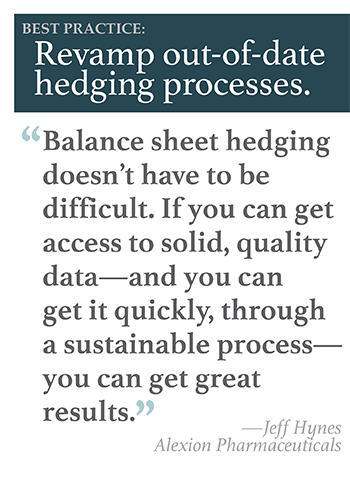
Based in Boston, Alexion Pharmaceuticals is a globalbiopharmaceutical company focused on serving patients and familiesaffected by rare diseases through the innovation, development, andcommercialization of life-changing therapies. The company does asignificant amount of business in 15 different currencies, soforeign exchange (FX) risk is top-of-mind for the treasury team.Nevertheless, when Alexion's revenue quadrupled over just fouryears, the sophistication of its FX processes needed to increasecommensurately.
|“A few years ago, we had two people in Switzerland placinghedges at a transactional level,” explains Jeff Hynes, assistanttreasurer. “They used spreadsheets to track the company's balancesheet and cash flow risks. They would look at each invoice orpayable coming in and decide whether to hedge it on a one-offbasis. It worked, but only because of the brute force they wereapplying in terms of manpower.”
|The pair would pull accounts receivable (A/R) data from thecompany's enterprise resource planning (ERP) system every day,because A/R is a large driver of Alexion's FX exposure. However,accounts payable (A/P) and other balances were sourced only weeklyor monthly because retrieving them was too time-consuming to merita daily schedule. Where they didn't have actuals data, the teamwould generate forecasts.
|“One of the individuals handling FX risk had been with thecompany for a long time, so he knew when to expect certain payablesand receivables to hit the books,” Hynes says. “For example, hemight know that one particular country would always receive largepayments on day 4 and day 12 of the month. He also knew thecontroller in every country, so he would regularly call them up andask whether transactions he was expecting had come through. Thenthe team would place hedges based on this informal forecastingprocess.”
|At the end of every month, they would close out the month'strades by aggregating them in a spreadsheet and netting the amountsby bank and by currency. This was inefficient and requiredextensive effort to avoid the potential for any data-entry errors.To prevent the process from becoming even more unwieldy, Alexionassigned each currency to a single bank.
|“If you have 10 banks, each settling trades in 10 currencies,you might have 100 payments to close out,” Hynes says. “That wouldbe an enormous headache because it would take so much time to workout the net value in spreadsheets. But if you have 10 banks andeach is assigned just one currency, you have just 10 accounts toclose out trades for. That approach kept the number of settlementswe needed to make from blowing up, but it also gave the banksleverage over pricing because they knew they had our business fortheir assigned currencies.”
|Not only were Alexion's FX risk management processesinefficient, but they also included key-person risks. “We were verydependent on that one person who knew everything about A/P and A/Rat the company,” Hynes says. “We had around $400 million in balancesheet hedges outstanding at any given time. At that size, we neededan FX risk management program where we were hedging balances, notindividual items, and we needed to be confident the hedging programwould continue to operate seamlessly if that one person left thecompany.”
|When Alexion decided to transition the Swiss treasury functionsto the United States, the time was right to upgrade the balancesheet hedging process. The Alexion treasury team decided to useautomation to capture changing FX exposures every day. Afterevaluating the risk management technology landscape, the companychose to implement FiREapps.
|Connecting FiREapps to the company's SAP ERP system required adata-validation process in which Alexion treasury discovered thatsome details of the company's ERP configuration could be improved.“There were some minor aspects of SAP that hadn't been set up in amanner to allow us to get the most out of FiREapps,” Hynes says.“The FiREapps implementation team helped us find areas where wecould improve, and once we implemented the changes they identified,we were able to proceed more efficiently and get the results wewanted.”
|Soon, exposure data was flowing smoothly. Now FiREapps receivescomplete information on the company's FX exposures from SAP everyday, as well as a file listing the open hedge positions fromAlexion's treasury management system. FiREapps uses this data tocalculate the company's net FX exposure, as well as to show how ithas changed in each currency pair since the last time Hynes' teamplaced a hedge.
|“All the file drops happen at the same time, before we get intothe office,” Hynes explains. “We get a report with our net FXexposure position. We arrive in the morning, look at the report tomake sure all of our positions are as expected, and check onanything we have concerns about. We haven't seen any data errors,but sometimes we need to check on timing issues.”
|When treasury is satisfied that the net position is up-to-dateand accurate, FiREapps recommends trades across any of 15 currencypairs. “We generally don't hedge unless our net exposure positionchanges by at least $1 million,” Hynes reports. “For changes thatare slightly higher than that floor, we use our judgment. When wewant to make a trade, we punch a button in FiREapps, and the tradeautomatically appears in FXall. Then we punch a button in FXall,and our position is hedged.”
|Once a month, Hynes' team also checks SAP for new accounts. Whenan account has been added, they make sure that its general ledger(G/L) codes map into FiREapps properly.
| The increase in efficiency hasbeen monumental. “Assuming the data looks good to us when we arrivein the morning, we can do the hedging in less than 15 minutes,”Hynes says. “Compare that with our previous environment, where twopeople were dedicated to FX hedging full-time.” Not only has staffproductivity improved dramatically, but treasury has reducedtrading costs by more than $1 million a year. Most of those savingscome from introducing competition among banks.
The increase in efficiency hasbeen monumental. “Assuming the data looks good to us when we arrivein the morning, we can do the hedging in less than 15 minutes,”Hynes says. “Compare that with our previous environment, where twopeople were dedicated to FX hedging full-time.” Not only has staffproductivity improved dramatically, but treasury has reducedtrading costs by more than $1 million a year. Most of those savingscome from introducing competition among banks.
“Since we automated these processes, it no longer matterswhether we have 10 trades to close out or 1,000,” Hynes says. “Wejust punch a button in our treasury management system and all thenetting is done for us. It no longer matters if one bank gets ourGBP business today and another gets GBP tomorrow. So now our bankshave to compete for each currency.”
|In addition, the new system provides much better visibility intothe company's current position in each major currency. Becausenetting was so challenging before, treasury would need to do verycareful and time-consuming analysis to make certain they did notenter into a hedge when exposures actually canceled each otherout.
|“This system provides us with clean, netted data every singleday,” Hynes says. “The whole idea was to get away fromtransactional hedges and move to balance-level hedging. We'vedriven down the pricing from banks by introducing competition, andwe can quickly perform the analysis to ensure that we're hedgingonly when we need to. At the same time, we've kept FX volatility toa minimum of about 1 cent per share.”
|Hynes concludes: “What I've learned from this process is thatbalance sheet hedging doesn't have to be difficult. If you can getaccess to solid, quality data—and you can get it quickly, through asustainable process—you can get great results. You'll have to boildown a lot of data to get there, but there are technology solutionson the market now that make it possible.”
|
See also:
And winners in our other categories of 2018 Alexander HamiltonAwards:
Complete your profile to continue reading and get FREE access to Treasury & Risk, part of your ALM digital membership.
Your access to unlimited Treasury & Risk content isn’t changing.
Once you are an ALM digital member, you’ll receive:
- Critical Treasury & Risk information including in-depth analysis of treasury and finance best practices, case studies with corporate innovators, informative newsletters, educational webcasts and videos, and resources from industry leaders.
- Exclusive discounts on ALM and Treasury & Risk events.
- Access to other award-winning ALM websites including PropertyCasualty360.com and Law.com.
*May exclude premium content
Already have an account? Sign In
© 2024 ALM Global, LLC, All Rights Reserved. Request academic re-use from www.copyright.com. All other uses, submit a request to [email protected]. For more information visit Asset & Logo Licensing.







